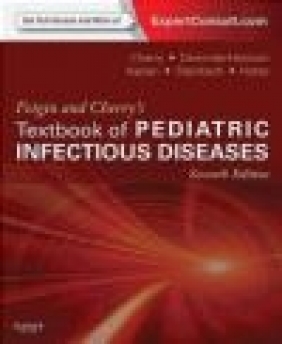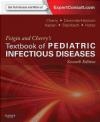Feigin and Cherry's Textbook of Pediatric Infectious Diseases
Sheldon L. Kaplan, Gail J. Demmler-Harrison, James D. Cherry
Feigin and Cherry's Textbook of Pediatric Infectious Diseases
Sheldon L. Kaplan, Gail J. Demmler-Harrison, James D. Cherry
- Producent: W.B. Saunders Company
- Rok produkcji: 2013
- ISBN: 9781455711772
- Ilość stron: 3200
- Oprawa: brak formatu
Niedostępna
Opis: Feigin and Cherry's Textbook of Pediatric Infectious Diseases - Sheldon L. Kaplan, Gail J. Demmler-Harrison, James D. Cherry
The new edition of this popular reference continues to present the critical answers you need to address your most difficult clinical challenges. It explores the latest advances in the treatment of pediatric disease, equipping you with unparalleled coverage of immunology, epidemiology, public health, preventive medicine, clinical manifestations, diagnosis, treatment, and much more. Extensive updates, including para- and post-infectious demyelinating diseases of the central nervous system, antibiotic resistance, and molecular techniques in laboratory diagnosis - just to name a few - enable you to put the very latest knowledge to work for your patients. Plus, as an Expert Consult title, the book comes with access to the complete contents online, fully searchable, plus links to Medline and PubMed abstracts-providing you with rapid and easy reference from any computer!
"This is the textbook to which all who desire a comprehensive exposition of pediatric infectious disease will turn.? - JAMA, review of the previous edition.
"The editors and publishers should be commended the first for being able to collect the data, the latter for the high technical quality of production. Contains an expert-consult searchable on-line. Highly recommended not only to specialists in infectious diseases and departments of pediatrics but to all pediatricians." Pediateic Endocrinology Reviews, December 2009Part I Host Parasite Relationships an dthe Pathogenesis of Infectious Diseases 1. Molecular Determinants of Microbial Pathogenesis 2. Normal and Impaired Immunologic Responses to Infection 3. Metabolic Response and Nutritional Aspects of the Host to Infections and Interaction of Infection and Nutrition 4. Fever: Pathogenesis and Treatment 5. The Human Microbiome 6. Epidemiology and Biostatistics of Infectious Diseases Part II Infection of Specific Organ Systems Section I Upper Respiratory Tract Infections 7. The Common Cold 8. Infections of the Oral Cavity 9. Pharyngitis (Pharyngitis, Tonsillitis, Tonsillopharyngitis, and Nasopharyngitis) 10. Uvulitis 11. Peritonsillar, Retropharyngeal and Parapharyngeal Abscesses 12. Cervical Lymphadenitis 13. Parotitis 14. Sinusitis 15. Otitis Externa 16. Otitis Media 17. Mastoiditis 18. Epiglottitis (Supraglottitis) Croup (Laryngitis, Laryngotracheitis, Spasmodic Croup, Laryngotracheobronchitis, Bacterial Tracheitis, and Laryngotracheobronchopneumonitis) Section II Lower Respiratory Tract Infections 19. Acute Bronchitis 20. Chronic Bronchitis 21. Bronchiolitis and Infectious Asthma 22. Community Acquired Pneumonias 23. Children's Interstitial Lung Disease and Hypersensitivity Pneumonitis 24. Pleural Effusions and Empyema, Lung Abscesses and Complications of Pneumonia 25. Cystic Fibrosis Section III: Infections of the Heart 26. Infective Endocarditis 27. Infectious Pericarditis 28. Myocarditis 29. Acute Rheumatic Fever 30. Mediastinitis Section IV: Central Nervous System Infections 31. Bacterial Meningitis Beyond the Neonatal Period 32. Brain abscesses Parameningeal Infections 33. Fungal Meningitis 34. Eosinophilic Meningitis 35. Aseptic Meningitis and Viral Meningitis 36. Encephalitis and Meningoencephalitis 37. Parainfections and Postinfectious Disorders of the Nervous System 37a. Parainfections and Postinfections Demyelinating Disorders of the Central Nervous System 37b. Infection-Associated Myelitis and Meylopathies of the Spinal Cord and . Parainfections and Postinfections Disorders of the Peripheral Nervous System Section V Genitourinary Tract Infections 38. Urethritis 39. Cystitis and Pyelonephritis 40. Renal Abscess 41. Prostatitis 42. Genital Infections Section VI Gastrointestinal Tract Infections 43. Esophagitis 44. Gastrointestinal Tract Infections and Food Poisoning 45. Antibiotic Associated Colitis 46. Whipple Disease Section VII Liver Disease 47. Hepatitis 48. Cholangitis and Cholecystitis 49. Pyogenic Liver Abscess 50. Reye Syndrome Section VIII Other Intra-Abdominal Infections 51. Appendicitis and Pelvic Abscess 52. Pancreatitis 53. Peritonitis and Intraabdominal Abscess 54. Retroperitoneal Infections Section IX Musculoskeletal Infections 55. Osteomyelitis 56. Septic Arthritis 57. Bacterial Myositis and Pyomyositis Section X Skin Infections 58. Cutaneous Manifestatiions of Systemic Infections 59. Roseola Infantum (Exanthem Subitum) 60. Skin Infections Section XI Ocular Infectious Diseases 61. Ocular Infectious Diseases Section XII Systemic Infectious Diseases 62. Bacteremia and Septic Shock 63. Fever Without Source and Fever of Unknown Origin 64. Toxic Shock Syndrome 65. Acute Respiratory Distress Syndrome in Children Section XIII Infections of the Fetus and Newborn 66. Approach to the Infections in the Fetus and Neonate (Fetal Congenital and Neonate) Section XIV Infections of the Compromised Host 67. Primary Immunodeficiencies 68. The Febril Neutropenic Patient 69. Opportunistic Infections In Hematopoietic Stem Cell Transplantation 70. Infections in Pediatric Heart Transplantaton 71. Infections in Pediatric Lung Transplantation 72. opportunistic Infections in Liver and Intestinal Transplantation 73. Opportunistic Infections in Kidney Transplantation 74. Infections Related to Prosthetic or Artificial Devices (Includes Shunt Infections) 75. Infections Related to Craniofacial Surgical Procedures 76. Infections in Burn Patients Section XV Unclassified Infectious Diseases 77. Kawasaki Disease 78. Chronic Fatigue Syndrome Part III Infections with Specific Microorganisms Section XVI Bacterial Infections 79. Nomenclature for Aerobic and Anaerobic Bacteria Subsection 1 Gram Positive Cocci 80. Staphylococcus Aureus Infections (Coagulase-Positive Staphylococci) 81. Coagulase -Negative Staphylococcal Infections 82. Group A, Group C and Group G Beta - Hemolytic Streptococcal Infection 83. Group B Streptococcal Infections 84. Enterococcal and Viridans Streptococcal Infections 85. Pneumococcal Infections 86. Miscellaneous Gram Positive Cocci Subsection 2 Gram Negative Cocci 87. Moraxella Catarrhalis 88. Meningococcal Infections 89. Gonococcal Infections Subsection 3 Gram Positive Bacilli 90. Diptheria 91. Anthrax 92. Bacillus Cereus 93. Arcanobacterium Haemolyticum 94. Erysipelothrix Rhusiopathiae 95. Listeriosis 96. Tuberculosis 97. Other Mycobacteria 98. Leprosy and Buruli Ulcer: The Major Cutaneous Mycobacterioses 99. Nocardia 100. Corynebacterium and Rhodococcus Subsection 4 Gram Negative Bacilli 101. Citrobacter 102. Enterobacter 103. Escherichia Coli 104. Diarrhea-Causing and Dysentery-Causing Escherichia coli 105. Klebsiella 106. Morganella Morganii 107. Proteus 108. Providencia 109. Shigella 110. Serratia 111. Salmonella 112. Plague (Yersinia Species) 113. Other Yersinia Species 114. Edwardsiella Tarda, Hafnia Alvei, Pantoea Agglemerans 115. Aeromonas 116. Pasteurella Multocida 117. Cholera 118. Vibrio Parahaemolyticus 119. Vibrio Vulnificus 120. Chromobacterium 121. Acinetobacter 122. Achromobacter 123. Eikenella Corrodens 124. Elizabethkingia and Chryseobacterium Species 125. Pseudomonas and Related Genera 126. Stenotrophomonas (Xanthomonas) Maltophilia Subsection 5 Gram Negative Coccobacilli 127. Actinobacillus Actinomycetemcomitans 128. Brucellosis 129. Pertussis and Other Bordetella Infections 130. Calymmatobacterium Granulomatis 131. Campylobacter Jejuni 132. Tularemia 133. Haemophilus Influenzae 134. Other Haemophilus Species Aphrophilus, Ducreyi, Haemolyticus, Influenzae Biogroup Aegyptius, Parahaemolyticus and Parainfluenzae 135. Helicobacter Pylori 136. Kingella Species 137. Legionella 138. Streptobacillus Moniliformis (Rat Bite Fever) 139. Bartonella Subsection 6 Treponemataceae 140. Borrelia (Relapsing Fever and Lyme Disease) 141. Leptospirosis 142. Spirillum Minus (Rat Bite Fever) 143. Syphylis 144. Nonvenereal Treponematoses Subsection 7 Anaerobic Bacteria 145. Clostridial Intoxications and Infection 146. Infant Botulism 147. Tetanus 148. Actinomycosis 149. Bacteroides Fusobacterium and Prevobella Section XVII: Viral Infections 150. Classification and Nomenclature of Viruses DNA Viruses - Subsection 1 Parvoviridae 151. Human Parvovirus 152. Human Bocaviruses DNA Viruses - Subsection 2 Polyomaviridae 153. Human Polyomaviruses 154. Human Papillomaviruses DNA Viruses - Subsection 3 Adenovirses 155. Adneoviruses DNA Viruses - Subsection 4 Hepatoviridae 156. Hepatitis B and D Viruses DNA Viruses - Subsection 5 Herpesvididae 157. Herpes Simplex Viruses 1 and 2 158. cytomegalovirus 159. Epstein Barr Virus 160. Human Heerpesviruses 6,7 and 8 161. Varicella Zoster Virus DNA Viruses - Subsection 6 Poxviridae 162. Smallpox (Variola Virus) 163. Monkey Pox and Other Pox Viruses 164. Mimiviruses RNA Viruses - Subsection 1 Picornaviridae 165. Enteroviruses and parechoviruses 166. Rhinoviruses 167. Hepatitis A Virus RNA Viruses - Subsection 2 Caliciviridae 168. Caliciviruses 169. Hepatitis E Virus RNA Viru
Szczegóły: Feigin and Cherry's Textbook of Pediatric Infectious Diseases - Sheldon L. Kaplan, Gail J. Demmler-Harrison, James D. Cherry
Tytuł: Feigin and Cherry's Textbook of Pediatric Infectious Diseases
Autor: Sheldon L. Kaplan, Gail J. Demmler-Harrison, James D. Cherry
Producent: W.B. Saunders Company
ISBN: 9781455711772
Rok produkcji: 2013
Ilość stron: 3200
Oprawa: brak formatu



























